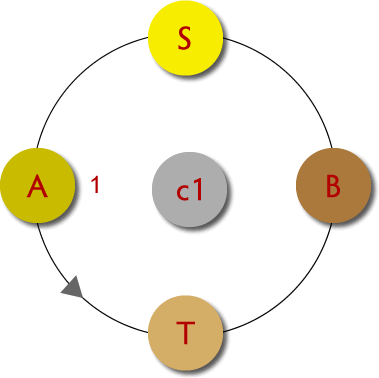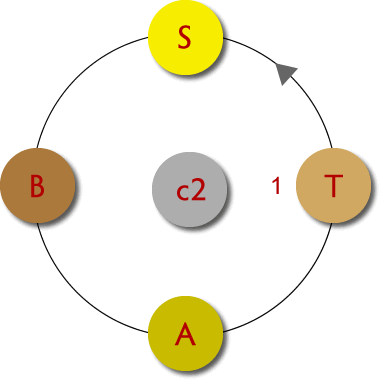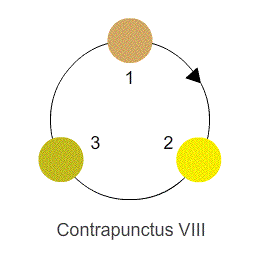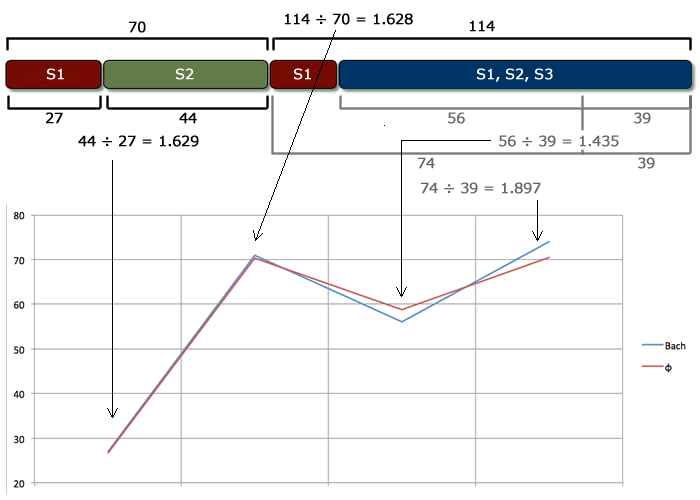Contrapunctus XI from the Art of the Fugue
José Rodríguez Alvira
Contrapunctus XI is a triple fugue based on the inverted subjects of Contrapunctus VIII.
This graphic shows the formal structure of the fugue. Click on any section for more information
First Exposition
The fugue starts with an exposition based on subject S1 ![]() , a variation of the Art of the Fugue subject:
, a variation of the Art of the Fugue subject:

This subject is the inversion of Contrapunctus VIII' s third subject:

The inverted version is also used in this fugue and will be identified as S1![]() .
.
The voices enter in the order alto, soprano, bass and tenor (c1a+). A short episode leads to one more presentation of S1 in the soprano in measure 22 and the section ends in D minor:
Second Exposition with Second Subject
A new exposition based on subject S2![]() begins in measure 27:
begins in measure 27:

This subject is the inversion of Contrapunctus VIII's first subject:

 The order of the voices is alto, tenor, bass and soprano ( c1a-). This order is the inversion of the order used in the first exposition. The last voice presents the inverted subject (S2
The order of the voices is alto, tenor, bass and soprano ( c1a-). This order is the inversion of the order used in the first exposition. The last voice presents the inverted subject (S2![]() ).
).
Long episodes are used between each voice entry (marked with dashed lines). Two important motives are present. One of chromatic character based on the S2 is used in ascending (soprano, measure 28) and descending (bass, measure 30) versions. The other has a more melodic character (alto, measure 31). The section ends in A minor:
Another Exposition with First Subject
 A new exposition using the inversion of S1 (S1
A new exposition using the inversion of S1 (S1![]() ) starts in measure 71. The order is now tenor, soprano, bass and alto (c2t-). The chromatic and melodic motives are used again. The section ends in F major:
) starts in measure 71. The order is now tenor, soprano, bass and alto (c2t-). The chromatic and melodic motives are used again. The section ends in F major:
Presentation of the 3 Subjects
The longest section of the fugue where Bach uses the 3 subjects begins in measure 89. This is the third subject S3 (S3![]() ):
):

It is a free inversion of Contrapunctus VIII's second subject:

The inverted version will also be used and will be identified as S3![]() .
.
Subjects are rotated between Contrapunctus VIII and XI in the following way:
| Contrapunctus VIII | Contrapunctus XI |
|---|---|
| 1 | 2 |
| 2 | 3 |
| 3 | 1 |

The next image resumes this section:
- We will divide the section in two parts: a first part (measures 89 to 144) where Bach uses S2 and S3 in original and inverted forms alternating with a few presentations of S1 and a second one where the 3 subjects are simultaneously used.
- We show only those cases where S3 appears in combination with the other subjects and we have not included all presentation because of numerous variations.
- At the end of measure 145 begins the first presentation of the 3 subjects (in Contrapunctus VIII the presentation of the 3 subjects is in measure 147).
- Subjects S1 are inverted at the tenth in measure 164.

The following image resumes the ways in which Bach combines the 3 subjects starting at measure 145. None of the voices repeats a subject and only the tenor presents all 3 subjects. Bach also changes the order in which each subject starts.

Here you can listen to the complete section. We have marked each subject. Using dashed lines we show the variations of S3 and the chromatic motive:
Relation Between Sections
If we compare the number of measures in each section, we find that some of them are close to the golden ratio (1.618). The ratio between the number of measures:
- in the first two sections and the last two section is 1.628
- between the first and second section is 1.629
If we try to subdivide the last two section (in gray on the image), we are not that close to the golden ratio
- dividing the number of measures in the last section using as middle point measure 145 where the 3 subjects appear for the first time, the ratio 1.435
- dividing the number of measures from the third section to measure 145, the ratio 1.987
Yet the difference in number of measures needed to be closer to the golden ratio is only between 3 and 4 measures. The bottom chart shows the difference between Bach actual measures (blue line) and the exact measure according to the golden ratio. As you can see the difference is not that big:

Complete Fugue
Recordings:
- Robert Hill, harpsichord
- Canadian Brass
- Hesperion XX - Jordi Savall, Director